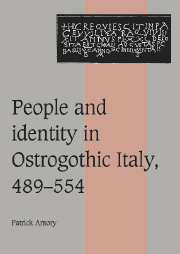Book contents
- Frontmatter
- Contents
- Preface
- List of rulers
- Terminology and vocabulary
- List of abbreviations
- Map of Ostrogothic Italy
- Introduction: Studying the barbarians in late antiquity
- 1 Ethnicity, ethnography and community in the fifth and sixth centuries
- 2 The Ravenna government and ethnographic ideology: from civilitas to bellicositas
- 3 Individual reactions to ideology I: names, language and profession
- 4 Complementary and competing ideals of community: Italy and the Roman Empire
- 5 Individual reactions to ideology II: soldiers, civilians and political allegiance
- 6 Catholic communities and Christian Empire
- 7 Individual reactions to ideology III: Catholics and Arians
- 8 The origin of the Goths and Balkan military culture
- Conclusion
- Appendix 1 The inquiry into Gundila's property: a translation and chronology
- Appendix 2 The Germanic culture construct
- Appendix 3 Archeological and toponymic research on Ostrogothic Italy
- Appendix 4 Dress, hairstyle and military customs
- Prosopographical Appendix: A prosopography of Goths in Italy, 489–554
- Bibliography
- Index
- Cambridge Studies in Medieval Life and Thought Fourth Series
Appendix 3 - Archeological and toponymic research on Ostrogothic Italy
Published online by Cambridge University Press: 03 December 2009
- Frontmatter
- Contents
- Preface
- List of rulers
- Terminology and vocabulary
- List of abbreviations
- Map of Ostrogothic Italy
- Introduction: Studying the barbarians in late antiquity
- 1 Ethnicity, ethnography and community in the fifth and sixth centuries
- 2 The Ravenna government and ethnographic ideology: from civilitas to bellicositas
- 3 Individual reactions to ideology I: names, language and profession
- 4 Complementary and competing ideals of community: Italy and the Roman Empire
- 5 Individual reactions to ideology II: soldiers, civilians and political allegiance
- 6 Catholic communities and Christian Empire
- 7 Individual reactions to ideology III: Catholics and Arians
- 8 The origin of the Goths and Balkan military culture
- Conclusion
- Appendix 1 The inquiry into Gundila's property: a translation and chronology
- Appendix 2 The Germanic culture construct
- Appendix 3 Archeological and toponymic research on Ostrogothic Italy
- Appendix 4 Dress, hairstyle and military customs
- Prosopographical Appendix: A prosopography of Goths in Italy, 489–554
- Bibliography
- Index
- Cambridge Studies in Medieval Life and Thought Fourth Series
Summary
Archeology and toponymic study could ideally provide interesting perspectives on the strength of local and familial identity in Ostrogothic Italy. Unfortunately, the limited synthesis of archeological evidence that has been undertaken to date is almost entirely the work of one man – Volker Bierbrauer, a German archeologist working in the obsolete ethnic-ascription tradition (on which see below). Most influential is his Die Ostgotischen Grab- und Schatzfunde in Italien, a book cited in every work on Ostrogothic history published since. In article after article, Bierbrauer continues to reiterate his basic theory: that the material culture that he calls “Ostrogothic,” such as brooches, fibulae and pottery, exactly mirrors the migration story told by Jordanes. A newer book by Michel Kazanski perpetuates Bierbrauer's claims to identify the migration of the Goths through a trail of artifacts from Scandinavia to southern Europe. Kazanski himself admits that his evidence does not show consistent presence of the same grave-goods in male graves, only in female graves. Thus even within their own ethnic-ascription theory, the theses of Kazanski and Bierbrauer are fragile. As it is, site reports on excavations from within Italy, scanty for this period anyway, are conditioned by the expectation that the results will reveal something about the ethnic affiliation of the people who lived on or were buried at the site. This expectation has theoretical holes.
- Type
- Chapter
- Information
- People and Identity in Ostrogothic Italy, 489–554 , pp. 332 - 337Publisher: Cambridge University PressPrint publication year: 1997



